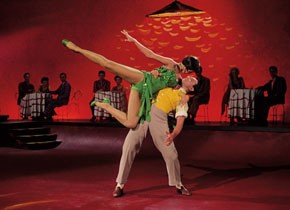Glorious Technicolor
From George Eastman House and Beyond
April 10 to May 3, 2015
There is hardly another brand name in the history of cinema that has achieved the legendary status of the Technicolor Corporation. As "Glorious Technicolor," the color process became a central component of the Classical Hollywood myth – the epitome of the dream factory’s supremacy as far as glamour, production expenditures and technical excellence were concerned. Technicolor was not just bigger than life, it was also more beautiful and more colorful: "Only the rainbow can duplicate its brilliance!" as the tagline went for The Adventures of Robin Hood, one of those 1930s breakthroughs that showed the future for color cinematography. Even though the use of Technicolor was very costly, and other (lesser, but more efficient) color processes were to take the lead by the mid-1950s, its effect on the industry was so striking that the iconic status of the company’s name is still intact today.
On the occasion of Technicolor Co.’s 100th anniversary, the Film Museum dedicates its program to that period which established the legend. It was only in 1932 that a specific method was perfected which allowed for the presentation of the entire color spectrum – the unique Three-Strip Technicolor. Until 1953, it set the standard for upscale Hollywood productions, including not only classics (from Gone With the Wind to Marilyn Monroe in Niagara and Gentlemen Prefer Blondes) but also rarely seen works, swashbucklers and musicals as well as early Disney animations and industrial films. The show traces a cinematic history that feeds upon many contradictory elements (commerce and aesthetics, technology and dream factory "magic") – and a material history which indicates some aspects of the prominence that analog film, as a cultural technique, is about to gain in the digital era.
This retrospective offers the rare opportunity to experience three-strip Technicolor in various stages of preservation, from original dye-transfer prints to contemporary restorations. Many of the exceptional loans presented in this framework are from the collection of the George Eastman House, which also initiated this anniversary program.
"Mr. Technicolor", Herbert T. Kalmus, the key figure of the three company founders, was never satisfied with the two-color process developed by the company during the silent era, despite several notable successes. Only the combination of red, green and blue color layers from three simultaneously exposed negatives (known as Process No. IV) satisfied his vision – and it still shapes the popular notion of Technicolor today. Where many competitors had failed, Kalmus persevered and promoted his expensive process into a quasi-monopoly: the three film strips needed heavier cameras, increased lighting expenses and made the printing process more expensive overall. The sceptical attitude from the major studios towards Technicolor disappeared only after the company signed an exclusive contract with Disney and short live-action films like La Cucaracha demonstrated color's drawing power with audiences.
Starting in 1935, Kalmus & Co. succeeded in establishing Technicolor as the "top of the line" color process for the largest Hollywood productions – with the worldwide hit Gone With The Wind as the apotheosis, and a high point for Technicolor as well (the company received a Special Oscar for its contribution to the film). From that time forward, dedicated Technicolor teams led by Kalmus' ex-wife Natalie would supervise the color coordination on movie sets and help create the signature "pastel look," which was meant to counteract the prejudice that color was only a garish enhancement for vulgar entertainments. The prototypical "Technicolor genres" illustrate this intention: adventure films and musicals, melodramas and Western pastorals came with certain audience expectations as far as visual pleasure was concerned, so the argument for “prestige treatment” met little resistance.
In spite of Technicolor’s rather strict system of rules as to how each color should be used, an amazing variety of approaches existed. In the first decade alone, the spectrum extends from the red-brown monochromatic landscapes of the desert (and the soul) in The Garden of Allah to the captivating natural tones of Henry Hathaway's unusual westerns (The Trail of the Lonesome Pine, The Shepherd of the Hills); from the Velázquez-, Goya- and El Greco-derived moods in Blood and Sand to the artificially glowing excesses of Duel in the Sun.
The color palettes of later highlights such as George Sidney's enthusiastic adventure films and musical masterpieces like Singin' in the Rain or An American in Paris already needed to distinguish themselves from the now-equally colorful midrange and low-budget productions, as competing processes such as Eastman Color entered the market in the late 1940s. Technicolor still had the advantage (there is no more beautiful film than Jacques Tourneur's "small" 1951 pirate film, Anne of the Indies), but the truly "glorious" Three-Strip era ended in 1954 with the introduction of Process No. V – with just a single strip of negative in the camera. Significantly, the Oscar for color photography that year for the first time went to a film that was not shot in Technicolor.
"Glorious Technicolor“ is a joint project of George Eastman House (Rochester), Deutsche Kinemathek (Berlin), the Austrian Film Museum and the Museum of Modern Art (New York).


